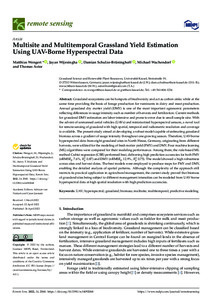| dc.date.accessioned | 2022-08-18T09:35:30Z | |
| dc.date.available | 2022-08-18T09:35:30Z | |
| dc.date.issued | 2022-04-26 | |
| dc.identifier | doi:10.17170/kobra-202208186688 | |
| dc.identifier.uri | http://hdl.handle.net/123456789/14078 | |
| dc.description.sponsorship | Gefördert durch den Publikationsfonds der Universität Kassel | |
| dc.language.iso | eng | |
| dc.rights | Namensnennung 4.0 International | * |
| dc.rights.uri | http://creativecommons.org/licenses/by/4.0/ | * |
| dc.subject | UAV | eng |
| dc.subject | hyperspectral | eng |
| dc.subject | grassland | eng |
| dc.subject | biomass | eng |
| dc.subject | multisite | eng |
| dc.subject | multitemporal | eng |
| dc.subject | predictive modeling | eng |
| dc.subject.ddc | 630 | |
| dc.title | Multisite and Multitemporal Grassland Yield Estimation Using UAV-Borne Hyperspectral Data | ger |
| dc.type | Aufsatz | |
| dcterms.abstract | Grassland ecosystems can be hotspots of biodiversity and act as carbon sinks while at the same time providing the basis of forage production for ruminants in dairy and meat production. Annual grassland dry matter yield (DMY) is one of the most important agronomic parameters reflecting differences in usage intensity such as number of harvests and fertilization. Current methods for grassland DMY estimation are labor-intensive and prone to error due to small sample size. With the advent of unmanned aerial vehicles (UAVs) and miniaturized hyperspectral sensors, a novel tool for remote sensing of grassland with high spatial, temporal and radiometric resolution and coverage is available. The present study aimed at developing a robust model capable of estimating grassland biomass across a gradient of usage intensity throughout one growing season. Therefore, UAV-borne hyperspectral data from eight grassland sites in North Hesse, Germany, originating from different harvests, were utilized for the modeling of fresh matter yield (FMY) and DMY. Four machine learning (ML) algorithms were compared for their modeling performance. Among them, the rule-based ML method Cubist regression (CBR) performed best, delivering high prediction accuracies for both FMY (nRMSEp 7.6%, R2p 0.87) and DMY (nRMSEp 12.9%, R2p 0.75). The model showed a high robustness across sites and harvest dates. The best models were employed to produce maps for FMY and DMY, enabling the detailed analysis of spatial patterns. Although the complexity of the approach still restricts its practical application in agricultural management, the current study proved that biomass of grassland sites being subject to different management intensities can be modeled from UAV-borne hyperspectral data at high spatial resolution with high prediction accuracies. | eng |
| dcterms.accessRights | open access | |
| dcterms.creator | Wengert, Matthias | |
| dcterms.creator | Wijesingha, Jayan | |
| dcterms.creator | Schulze-Brüninghoff, Damian | |
| dcterms.creator | Wachendorf, Michael | |
| dcterms.creator | Astor, Thomas | |
| dc.relation.doi | doi:10.3390/rs14092068 | |
| dc.subject.swd | Grünlandwirtschaft | ger |
| dc.subject.swd | Ertrag | ger |
| dc.subject.swd | Biomasse | ger |
| dc.subject.swd | Modellprädiktive Regelung | ger |
| dc.type.version | publishedVersion | |
| dcterms.source.identifier | eissn:2072-4292 | |
| dcterms.source.issue | Issue 9 | |
| dcterms.source.journal | Remote sensing | eng |
| dcterms.source.volume | Volume 14 | |
| kup.iskup | false | |
| dcterms.source.articlenumber | 2068 | |


